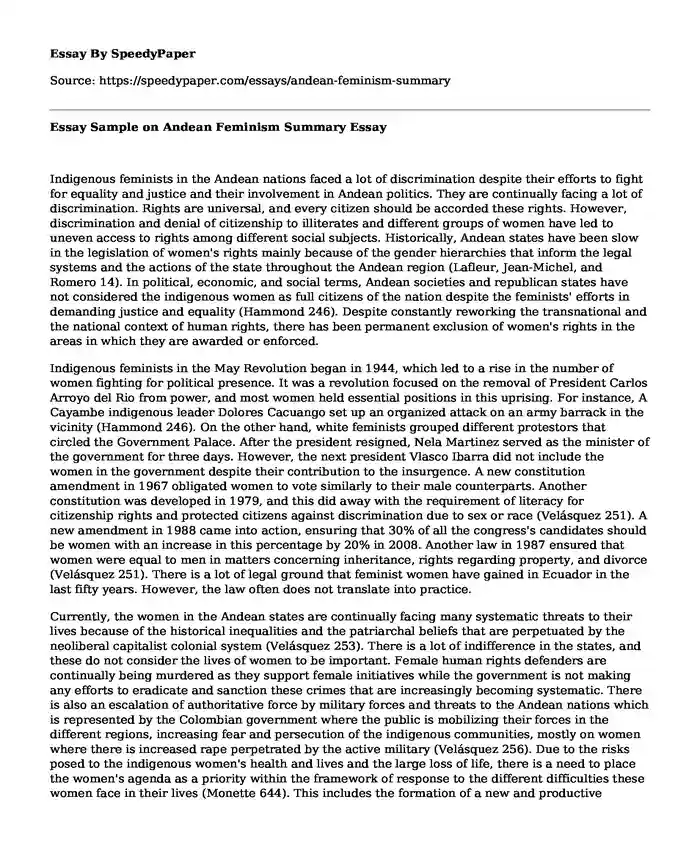
| Type of paper: | Essay |
| Categories: | Politics Discrimination Feminism |
| Pages: | 3 |
| Wordcount: | 717 words |
Indigenous feminists in the Andean nations faced a lot of discrimination despite their efforts to fight for equality and justice and their involvement in Andean politics. They are continually facing a lot of discrimination. Rights are universal, and every citizen should be accorded these rights. However, discrimination and denial of citizenship to illiterates and different groups of women have led to uneven access to rights among different social subjects. Historically, Andean states have been slow in the legislation of women's rights mainly because of the gender hierarchies that inform the legal systems and the actions of the state throughout the Andean region (Lafleur, Jean-Michel, and Romero 14). In political, economic, and social terms, Andean societies and republican states have not considered the indigenous women as full citizens of the nation despite the feminists' efforts in demanding justice and equality (Hammond 246). Despite constantly reworking the transnational and the national context of human rights, there has been permanent exclusion of women's rights in the areas in which they are awarded or enforced.
Indigenous feminists in the May Revolution began in 1944, which led to a rise in the number of women fighting for political presence. It was a revolution focused on the removal of President Carlos Arroyo del Rio from power, and most women held essential positions in this uprising. For instance, A Cayambe indigenous leader Dolores Cacuango set up an organized attack on an army barrack in the vicinity (Hammond 246). On the other hand, white feminists grouped different protestors that circled the Government Palace. After the president resigned, Nela Martinez served as the minister of the government for three days. However, the next president Vlasco Ibarra did not include the women in the government despite their contribution to the insurgence. A new constitution amendment in 1967 obligated women to vote similarly to their male counterparts. Another constitution was developed in 1979, and this did away with the requirement of literacy for citizenship rights and protected citizens against discrimination due to sex or race (Velásquez 251). A new amendment in 1988 came into action, ensuring that 30% of all the congress's candidates should be women with an increase in this percentage by 20% in 2008. Another law in 1987 ensured that women were equal to men in matters concerning inheritance, rights regarding property, and divorce (Velásquez 251). There is a lot of legal ground that feminist women have gained in Ecuador in the last fifty years. However, the law often does not translate into practice.
Currently, the women in the Andean states are continually facing many systematic threats to their lives because of the historical inequalities and the patriarchal beliefs that are perpetuated by the neoliberal capitalist colonial system (Velásquez 253). There is a lot of indifference in the states, and these do not consider the lives of women to be important. Female human rights defenders are continually being murdered as they support female initiatives while the government is not making any efforts to eradicate and sanction these crimes that are increasingly becoming systematic. There is also an escalation of authoritative force by military forces and threats to the Andean nations which is represented by the Colombian government where the public is mobilizing their forces in the different regions, increasing fear and persecution of the indigenous communities, mostly on women where there is increased rape perpetrated by the active military (Velásquez 256). Due to the risks posed to the indigenous women's health and lives and the large loss of life, there is a need to place the women's agenda as a priority within the framework of response to the different difficulties these women face in their lives (Monette 644). This includes the formation of a new and productive feminist organization based on sustainability, equality, and justice. This would guarantee that there is sovereignty in the territories and a harmonious relationship with nature.
Works Cited
Hammond, Gregory. "Women's Place in the Andes: Engaging Decolonial Feminists Anthropology." The Latin Americanist 63.2 (2019): 246-247.
Lafleur, Jean-Michel, and Maria Vivas Romero. "Combining transnational and intersectional approaches to immigrants' social protection: The case of Andean families' access to health." Comparative migration studies 6.1 (2018): 14.
Monette, Marie-Eve. "Decolonial Approaches to Latin American Literature and Cultures." (2018): 643-645.
Velásquez, Teresa A. "Enacting refusals: Mestiza women’s anti-mining activism in Andean Ecuador." Latin American and Caribbean Ethnic Studies 12.3 (2017): 250-272.
Cite this page
Essay Sample on Andean Feminism Summary. (2023, Oct 29). Retrieved from https://speedypaper.net/essays/andean-feminism-summary
Request Removal
If you are the original author of this essay and no longer wish to have it published on the SpeedyPaper website, please click below to request its removal:
- Free Essay on Consumerism Society
- The Mask You Live in Summary. Free Essay on the Movie.
- Essay Example on the Evils of Slavery in Uncle Tom's Cabin
- California Sexual Assault Politics, Essay Example for Free
- Correctional Management: Gaining Skills to Manage Facilities & Assuring Career Success - Essay Sample
- Essay Sample on The African Assertion: A Critical Anthropology of African Literature
- A Short Narrative of My Life - Essay Sample
Popular categories




